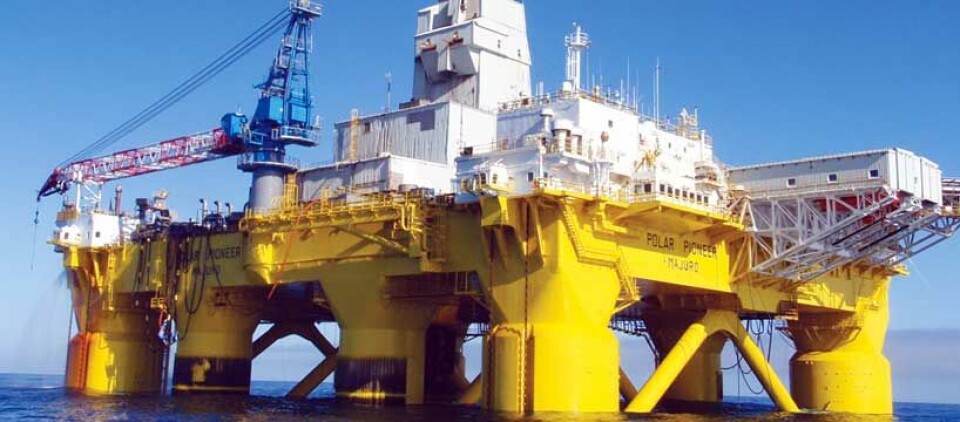
Cut fuel costs and reduce emissions
In 2009, the power management system onboard the Transocean rig, “Polar Pioneer”, was replaced by a Delomatic 4. The changeover resulted in reduced fuel costs, fewer emissions and more efficient engines.
Denne artikkelen er tre år eller eldre.
Every 24 hours, the “Polar Pioneer”'s fuel consumption is logged. In early 2009, as the recently installed Delomatic 4 was commissioned, log entries showed an abrupt and remarkable decline. Since then, a more regular pattern has emerged, showing a permanently reduced fuel intake well below previous levels. Accordingly, the rig's fuel costs have dropped like a stone.
Cost savings part of the design
Harmful emissions have also gone down. According to Øyvind Bjørløw, Transocean's machinist on the rig, this fact is not just a source of feel-good green conscience.
»Actually, saving fuel has generated a substantial windfall in terms of fewer environmental taxes on e.g. NOx«, the machinist says. In his opinion, the Delomatic 4 has added a welcome short-term economic dimension to Transocean's long-term commitment to environmental sustainability.
The reason for the Delomatic 4's fuel efficiency is its preference for heavy load on a few engines over easy load on several engines. This distribution of load saves fuel and thus causes fewer emissions.
Flexible under pressure
Transocean wanted the new power management system for their rig to control five diesel generators, one bus tie breaker, reduction signals, interfacing to thrusters and drilling equipment, tripping of load groups and various alarm interfacing to existing equipment. Transocean's Norwegian business connection, GMC Elektro, knew that the Delomatic 4 would be the right solution for this job and contacted DEIF's Norwegian subsidiary in Sem.
The situation was urgent. Installation and commissioning had to be completed within two weeks before the rig was scheduled to leave the dockyard. The hardware therefore had to be delivered very quickly. Also, engineering details would have to be finalised on the fly while installing and commissioning the system. This would put a lot of pressure on the developers customising the software.
»Under normal circumstances, a serious engineering effort on such a project would have required up to two months of work«, Kolbein Tjelle of GMC Elektro estimates. Yet, although the terms were difficult, DEIF agreed to the job.
Ready in less than two weeks
The hardware was delivered within a few days. By day 10, the wiring was complete. In less than two weeks, the technical service teams were ready for a DEIF engineer to carry out the final software adjustments before commissioning the new system. Only a few days later onboard the rig, FAT and DNV approvals were granted.
Sloppy work, then? Not according to Øyvind Bjørløw. He believes that the new power management system has improved the rig's engine control markedly.
»The Delomatic 4 has ensured a much more even load distribution, which has made the engines far more stable. Our previous system required more gen-sets to achieve the same performance as the Delomatic 4. The rig's engines operate much more efficiently today«, the machinist summarises.
Per Stein Tømmerstøl is responsible for the day-to-day operation of the engines. He agrees with his colleague's favourable appraisal and adds:
»The whole process of getting to know the Delomatic 4, the open dialogue with DEIF and the instructive training programme have all been absolutely outstanding«.
DEIF Norway's manager, Nils Askjer, is very satisfied that Transocean's demands were met. He remarks that many projects are a race against time. But time pressure is no excuse for poor engineering or finishing late.
»We did everything within our powers to finish up to standard and on time in spite of both holidays and a short deadline«, Nils Askjer says about the job for Transocean. »But then, we always do«, he smiles.
“Polar Pioneer” – main particulars
Built 1985
Yard Hitachi Zosen, Ariake Works - Nagasu
Upgrade 1994-99
Length o.a. 116m
Breadth (mld) 75m
Class DNV-14125 and A1 Column Stabilised Unit
Tonnages 38,564 (GT)/11,570 (NT)
Engine details:
Total Bhp. 19,430
Total kW 14,300
Type KVG-18
Make Bergen Diesel











